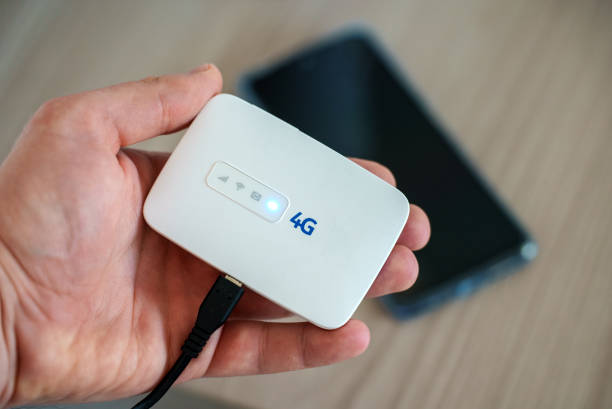Introduction
Portable WiFi devices, also known as MiFi routers or mobile hotspots, have become an essential tool for travelers, businesses, and everyday users who need reliable internet on the go. While many of these devices rely on traditional consumer SIM cards, more organizations and end-users are now turning to IoT SIM cards to power portable WiFi solutions.
This guide explores how IoT SIM cards enhance portable WiFi, why they matter for global IoT connectivity, and how businesses and individuals can take advantage of their unique benefits. From travel to enterprise deployments, portable WiFi with IoT SIM cards offers a new level of flexibility, security, and scalability.
What Is Portable WiFi?
Portable WiFi refers to a small, battery-powered device that acts as a wireless hotspot. Users insert a SIM card into the device, and it provides internet access to smartphones, laptops, tablets, or IoT devices within range.
Key Features of Portable WiFi Devices:
- Mobility: Easy to carry, works anywhere with cellular coverage.
- Multi-Device Connectivity: Supports 5–20 devices simultaneously.
- Independence: Operates without relying on public WiFi or wired networks.
Portable WiFi devices are widely used by international travelers, remote workers, and business teams in the field.
What Is an IoT SIM Card?
In today’s hyper-connected world, staying online is no longer a luxury but a necessity. Whether you are a digital nomad traveling across continents, a business professional attending international conferences, or simply a family on vacation, having reliable internet access on the go is crucial. This is where portable WiFi—also known as pocket WiFi, mobile WiFi router, or MiFi device—comes into play.
Portable WiFi is essentially a small, lightweight, battery-powered device that connects to the internet using a SIM card (increasingly an IoT SIM card for better flexibility and roaming capabilities). Once connected to a 4G, LTE, or 5G cellular network, the device creates a secure personal WiFi hotspot. This hotspot can then be shared with multiple devices, including smartphones, laptops, tablets, smart cameras, or even IoT-enabled gadgets.
Key Features of Portable WiFi Devices
- Mobility and Convenience: Unlike fixed home broadband, portable WiFi devices can be carried anywhere, making them ideal for travelers, field workers, and international businesses.
- Multi-Device Connectivity: A single device can support between 5 and 15 simultaneous connections, making it useful for group travel or small teams.
- Enhanced Security: Public WiFi in airports, hotels, or cafés is often unsecured. Portable WiFi creates a private, encrypted connection, significantly reducing cyber risks.
- Cross-Border Flexibility: With a global IoT SIM card, portable WiFi devices can automatically switch networks in different countries, eliminating the hassle of buying local SIM cards.
- Cost-Effective Data Management: IoT SIM cards enable flexible data plans such as pay-as-you-go, pooled data for businesses, or regional bundles that reduce roaming charges.
Portable WiFi vs. Smartphone Hotspot
At first glance, one might wonder why not simply use a smartphone as a hotspot. While modern smartphones can share their internet connection, there are significant differences:
- Battery Performance: A portable WiFi device has its own dedicated battery, often lasting 10–20 hours, while a smartphone hotspot drains your phone rapidly.
- Network Stability: Portable WiFi devices are equipped with stronger antennas, ensuring more stable connections in weak coverage areas.
- Device Support: Smartphones typically struggle with multiple simultaneous connections, whereas portable WiFi devices are designed for multi-user environments.
- Global IoT Connectivity: Most smartphones are limited to consumer SIM cards tied to one country or operator. In contrast, portable WiFi devices powered by IoT SIM cards provide seamless international coverage across hundreds of operators worldwide.
Why IoT SIM Cards Make Portable WiFi Smarter
Traditional SIM cards are not always optimized for global roaming or machine-to-machine applications. By integrating IoT SIM cards, portable WiFi devices benefit from:
- Automatic Network Switching: IoT SIM cards can intelligently connect to the strongest available network, improving user experience in remote or international locations.
- Centralized Management: For enterprises deploying multiple devices (e.g., for logistics fleets or global workforce), IoT SIM management platforms allow real-time monitoring, usage alerts, and policy control.
- Scalable Solutions: From individual users to large enterprises, IoT SIM cards support scalable deployment with flexible pricing models.
In short, portable WiFi with IoT SIM cards is more than just a travel gadget—it is a strategic solution for global IoT connectivity, ensuring reliable, secure, and cost-effective internet access across borders.
Use Cases of Portable WiFi with IoT SIM Cards
1. Travel and Tourism
- Tourists can avoid expensive roaming charges by using a portable WiFi device with a global IoT SIM.
- Hotels and travel agencies offer portable WiFi rentals to enhance guest experiences.
2. Enterprise and Field Teams
- Sales teams on the road need secure internet access for CRM tools.
- Construction and engineering teams rely on portable WiFi to connect IoT devices on-site.
3. Education and Remote Learning
- Schools provide portable WiFi to students in areas without reliable fixed broadband.
- IoT SIMs ensure connectivity across different regions and networks.
4. Healthcare
- Mobile clinics and ambulances use portable WiFi for patient data uploads.
- IoT SIM cards ensure connectivity even in rural or cross-border regions.
5. Emergency Response
- Disaster recovery teams use portable WiFi hotspots for real-time communication.
- IoT SIMs guarantee network redundancy during critical operations.
Technology Behind Portable WiFi and IoT SIM Integration
Network Types
- 4G LTE and 5G: Provide high-speed data for portable WiFi routers.
- NB-IoT and LTE-M: Low-power alternatives for specific IoT connectivity needs.
eSIM and iSIM Trends
- eSIM technology eliminates the need for physical SIM swapping, making portable WiFi devices more flexible.
- iSIM integrates SIM functionality directly into device hardware for added security and efficiency.
Cloud-Based Management
IoT SIMs are often supported by platforms where businesses can:
- Monitor data usage per device.
- Suspend or activate SIMs remotely.
- Set alerts for unusual activity.
Portable WiFi with IoT SIM vs Traditional SIM
| Feature | Traditional SIM | IoT SIM Card |
|---|---|---|
| Network Access | Single carrier | Multi-carrier, global roaming |
| Management | Limited | Centralized IoT management |
| Security | Standard APN | Private APN, VPN, encryption |
| Scalability | Not business-friendly | Designed for large deployments |
| Cost Control | Fixed plans, roaming fees | Flexible data bundles, cost caps |
How Businesses Benefit from IoT SIM-Powered Portable WiFi
- Improved Productivity: Teams stay connected anywhere.
- Reduced Costs: No need for multiple local SIM cards.
- Better Security: Corporate data transmitted via secure IoT networks.
- Simplified Logistics: One provider for global operations.
Zhongyi IoT: Delivering Reliable IoT SIM Solutions
At Zhongyi IoT, we specialize in providing IoT SIM card solutions for businesses and individuals around the world.
Our Advantages:
- Global IoT Connectivity across 190+ countries.
- Multi-network support with automatic switching.
- Competitive pricing with flexible data plans.
- Centralized management platform for easy SIM lifecycle control.
- Custom solutions for industries like travel, security, logistics, and healthcare.
Whether you need portable WiFi for international travel, field team deployments, or enterprise-scale operations, Zhongyi IoT delivers secure, reliable, and cost-effective connectivity.
Future of Portable WiFi with IoT Connectivity
- 5G-enabled MiFi devices will offer faster speeds and lower latency.
- AI-powered management platforms will optimize data usage automatically.
- Integration with smart city infrastructure will expand use cases.
- eSIM and iSIM adoption will eliminate the hassle of physical SIM swaps.
Conclusion
Portable WiFi devices are no longer just travel gadgets—they are critical tools for businesses, healthcare providers, and global travelers. By combining portable WiFi with IoT SIM cards, users can enjoy seamless global IoT connectivity, enhanced security, and lower costs.
With providers like Zhongyi IoT, organizations gain access to tailored IoT SIM solutions that make portable WiFi smarter, more reliable, and future-ready.



